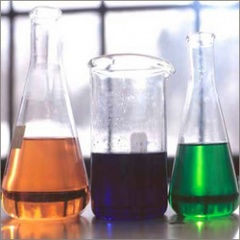Acids
| Infobox on Acids | |
|---|---|
| Example of Acids |  |
| Facts | |
| Origin | Various |
| Stowage factor (in m3/t) | - |
| Humidity / moisture | - |
| Ventilation | - |
| Risk factors | See text |
Acids
Contents
Description
An acid is a substance which reacts with a base. Commonly, acids can be identified as tasting sour, reacting with metals such as calcium, and bases like sodium carbonate. Aqueous acids have a pH under 7, with acidity increasing the lower the pH. Chemicals or substances having the property of an acid are said to be acidic.
Common examples of acids include acetic acid (in vinegar), sulfuric acid (used in car batteries), and tartaric acid (used in baking). As these three examples show, acids can be solutions, liquids, or solids. Gases such as hydrogen chloride can be acids as well. Strong acids and some concentrated weak acids are corrosive, but there are exceptions such as carboranes and boric acid.
There are three common definitions for acids: the Arrhenius definition, the Brønsted-Lowry definition, and the Lewis definition. The Arrhenius definition states that acids are substances which increase the concentration of hydronium ions (H3O+) in solution. The Brønsted-Lowry definition is an expansion: an acid is a substance which can act as a proton donor. Most acids encountered in everyday life are aqueous solutions, or can be dissolved in water, and these two definitions are most relevant. The reason why pHs of acids are less than 7 is that the concentration of hydronium ions is greater than 10−7 moles per liter. Since pH is defined as the negative logarithm of the concentration of hydronium ions, acids thus have pHs of less than 7. By the Brønsted-Lowry definition, any compound which can easily be deprotonated can be considered an acid. Examples include alcohols and amines which contain O-H or N-H fragments.
In chemistry, the Lewis definition of acidity is frequently encountered. Lewis acids are electron-pair acceptors. Examples of Lewis acids include all metal cations, and electron-deficient molecules such as boron trifluoride and aluminium trichloride. Hydronium ions are acids according to all three definitions. Interestingly, although alcohols and amines can be Brønsted-Lowry acids as mentioned above, they can also function as Lewis bases due to the lone pairs of electrons on their oxygen and nitrogen atoms.
Acids may be solid, liquid or gaseous, and are usually classified as Inorganic or Mineral Acids and Organic Acids.
Generally speaking all mineral acids are more or less corrosive, as are many organic acids. Some organic acids are completely harmless.
Corrosive acids are those which readily attack other substances, especially metal and timber, and will cause considerable damage should leakage occur. Such acids should never be handled as they are also corrosive to skin and other human tissue. Poisonous acids are those which are poisonous in themselves or evolve poisonous fumes, which are a danger to life.
Reference is made to the relevant IMO regulations of hazardous cargo.











